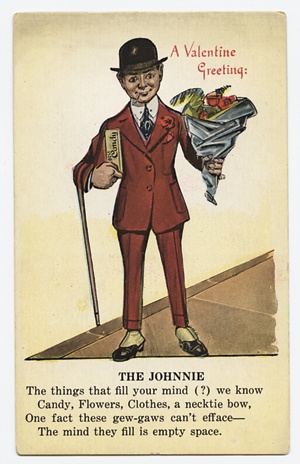Who can resist a valentine? You’ll find 50-year-old valentines stuck in Bibles, yellowing in keepsake boxes and moldering away in desk and dresser drawers. Throwing away a valentine is hard to do.
Featuring cherubs and nesting birds, red hearts pierced by Cupid’s arrows, rhyming words like moon and June and that sweet old question, “Will you be mine?” valentines are the perfect greeting to perk up the last dreary month of winter.
Valentine’s Day is different from most other holidays—it’s neither governmental nor religious; schools, banks and stores remain open, but still we celebrate it. And we feel forlorn without the attention. Don’t ever fool yourself—men love receiving valentines. I’ve never known a man who wasn’t happy—sometimes maybe sheepishly so—when he opened one. And if you want to really intrigue the man in your life, go ahead and send him a beautiful valentine signed with your name, of course, and then send him one mysteriously signed “a secret admirer.” Catnip!
Many interesting legends about this lovesome day have come down to us from the past. It was thought that the first eligible young man that a young woman saw on Valentine’s Day would be her valentine. (My grandmother teased her daughters and granddaughters about this. She told us all to “dress up” and look beautiful when we went out on Valentine’s Day.)
To be awakened by a kiss on Valentine’s Day was supposed to bring good luck all year long. Other people believed that you would see your lover’s face in a dream on Valentine’s eve if you slept with bay leaves sprinkled with rose water under your pillow.
The heart, the shape of the valentine, is an ancient symbol of love. We often think of the heart as the center of feelings. Thanks to modern science we know better, but we still speak of being “brokenhearted.” Those who are quick to reveal their emotions are said to “wear their hearts on their sleeves.” And when we part with the one we love, we sometimes say, “I’ll hold you in my heart.”
The heart is also associated with Cupid. In Roman mythology, this curly-haired, winged boy flew around zinging arrows into people’s hearts. The arrows did not kill, but made the victim fall in love with whomever was nearest. The mischievous Cupid shot his arrows with careless abandon, and the most unlikely folks would fall in love. (Still do, don’t they?)
But in a surprising twist, during the late 1800s, according to some sources, valentines turned mean and nasty. They made fun of fat people, thin people, old and wrinkled people, little kids and almost everyone else. These cards made people so unhappy that Valentine’s Day was not popular for a while. One of these poisonous missives meant for a postman went:
Haste thee with this valentine, thou silly man of letters,
And try to do the best you can to serve and please your betters,
For I’d sooner live an old maid or else give up the ghost,
Than wed a grinning postman as stupid as a post.
Another that could ruin your day featured the message: “Do I want you to be my valentine?”
And on the inside: “Nope.”
These spiteful cards were called “vinegar valentines.” Naturally, they were usually unsigned.
According to some sources, they remained popular through the first quarter of the 20th century, when, fortunately, such ugliness fell out of favor and cards became sweet again:
Distance between two hearts is not an obstacle …
Rather a beautiful reminder of just how strong true love can be.
Today, greeting card manufacturers make valentines to send to nearly everyone—from your aunt’s husband’s stepson, foster child’s birth mother, to your very own sweetheart. In fact, aside from Christmas, more cards are bought for Valentine’s Day than any other. But that’s a good thing—February 14 is a fine day to tell people how much we care for them and spread some love around.
So make your family happy by sending them valentines. As a project, sit down with your kids or grandkids and send a valentine to at least one person who might not receive a card. Sign the cards “guess who” or “your secret admirer.” Go on, do it. A little love is easy to spread around. Talk about your random acts of kindness!
——————–
Juddi Morris, a transplanted Texan who’s taken root in Paso Robles, California, never throws away a valentine, such as the one representing an eighth-grade crush she uses for a bookmark. Although tattered by time, she calls it “lacy.”


